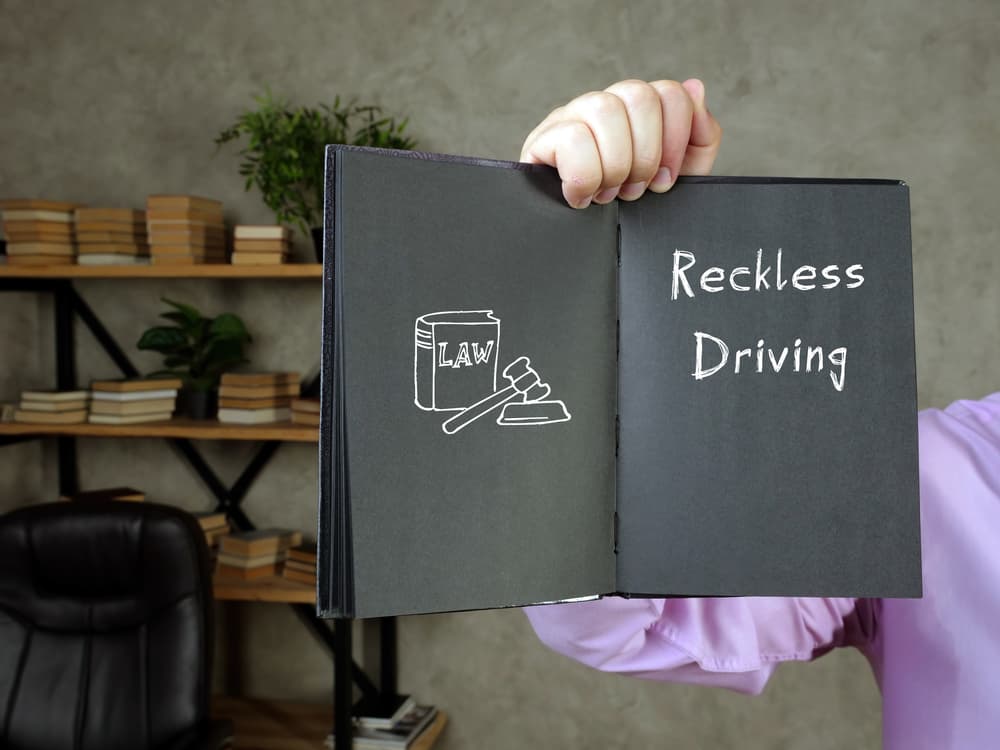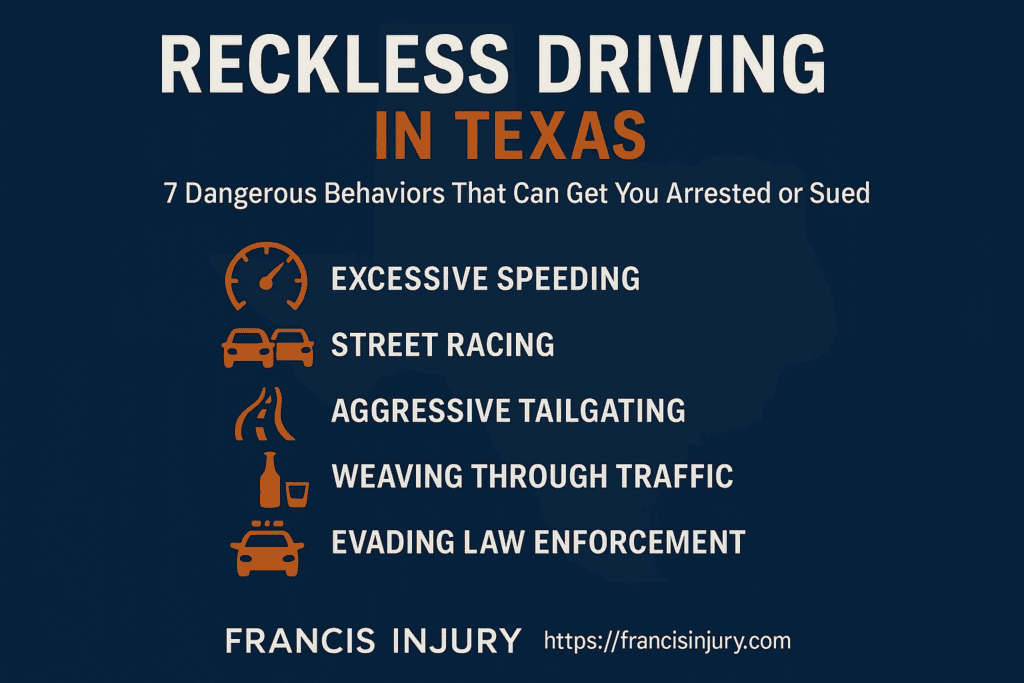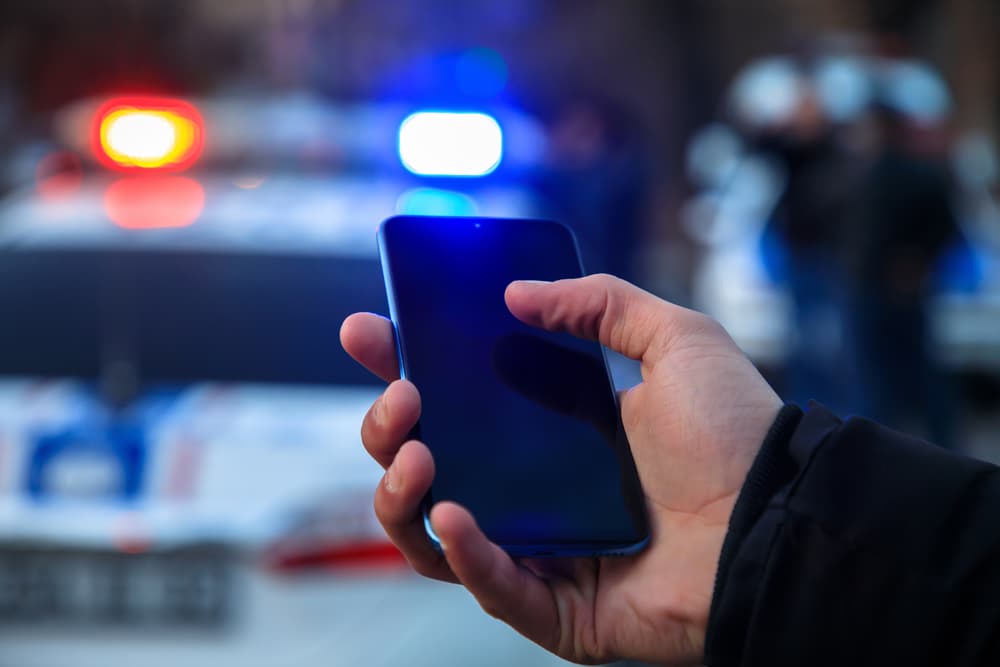Reckless driving is a serious traffic offense that endangers the lives of the driver, passengers, and others on the road. It encompasses many dangerous driving behaviors that can lead to severe consequences, including fines, license suspension, and even imprisonment.

Examples of Reckless Driving in Texas
Under Texas law, reckless driving is defined as operating a vehicle with willful disregard for the safety of persons or property. Below are common examples of reckless driving behavior that can lead to tickets, arrests, or serious accidents:
- Excessive Speeding: Driving more than 25 mph over the posted speed limit, especially in school zones or residential areas, is considered reckless and dangerous.
- Street Racing: Participating in unsanctioned races on public roads can lead to criminal charges and vehicle impoundment.
- Running Red Lights or Stop Signs: Ignoring traffic signals and signs puts pedestrians and other drivers at risk and is a textbook example of reckless conduct.
- Aggressive Tailgating: Following another vehicle too closely, particularly at high speeds, is a serious safety hazard and often results in rear-end collisions.
- Weaving Through Traffic: Frequently switching lanes at high speed without signaling or proper space endangers everyone on the road.
- Driving Under the Influence: Operating a vehicle while impaired by alcohol or drugs is both illegal and inherently reckless.
- Evading Law Enforcement: Attempting to flee a traffic stop or police pursuit is not only reckless—it’s a felony offense in many cases.
These behaviors are not just dangerous—they carry serious legal consequences. If you've been involved in a crash involving a reckless driver, contact our Fort Worth car accident lawyer to understand your rights and potential compensation.
Continue reading below to explore what constitutes reckless driving, the legal consequences, and how to prevent it.
By understanding the risks associated with reckless driving and adopting safe driving practices, we can all contribute to making our roads safer for everyone.
If you or a loved one has suffered injuries in an accident caused by another driver’s reckless driving, reach out to a skilled car accident lawyer near you for legal assistance.
Schedule Your Free Consultation
What Is Reckless Driving?
Reckless driving endangers the lives of the driver, passengers, and others on the road. While the specific definition of reckless driving may vary depending on state and local laws, the Federal Motor Carrier Safety Administration (FMCSA) broadly characterizes it as operating a motor vehicle with a willful or wanton disregard for the safety of individuals and property.
Reckless driving involves a deliberate or intentional disregard for traffic laws and safe vehicle operation, despite the driver's awareness that their actions could cause harm or damage. This behavior demonstrates a conscious choice to ignore the potential consequences of dangerous driving practices, placing the well-being of themselves and others at risk.

Some more examples of reckless driving include:
1. Excessive Speeding

Driving significantly above the posted speed limit is one of the most common forms of reckless driving. Driving 25 miles per hour or more over the speed limit in most states can result in a reckless driving charge.
Excessive speeding reduces a driver's reaction time and increases the likelihood and severity of accidents. For example, if a driver travels 90 miles per hour in a 60 miles per hour zone, they excessively speed.
At such high speeds, the driver has less time to react to changes in road conditions, such as a sudden stop in traffic or a pedestrian crossing the street. Additionally, the impact force in a collision at high speeds is much greater, leading to more severe injuries and damage.
2. Ignoring Traffic Signs and Signals
Disregarding traffic signs and signals, such as stop signs, yield signs, and red lights, is another form of reckless driving. These signs and signals are put in place to regulate traffic flow and ensure the safety of all road users. Running a red light or failing to stop at a stop sign can lead to serious collisions, particularly at intersections.
Imagine a driver approaching a busy intersection with a red light. Instead of stopping, the driver decides to accelerate and run the red light, putting themselves and others at risk.
This action can easily lead to a T-bone collision with vehicles that have the right of way, causing severe injuries or fatalities.
3. Improper Lane Changes and Weaving
Reckless driving also includes improper lane changes and weaving through traffic. This involves changing lanes without signaling, cutting off other vehicles, or swerving in and out of lanes to navigate through traffic.
These maneuvers can startle other drivers and lead to accidents, especially at high speeds or in heavy traffic.
Picture a driver on a busy highway, rapidly changing lanes without using their turn signal and barely leaving enough space between vehicles. This behavior can cause other drivers to brake suddenly or swerve to avoid a collision, potentially leading to a multi-vehicle accident.
4. Tailgating
Following another vehicle too closely, or tailgating, is considered reckless driving. Tailgating leaves insufficient space for the following vehicle to react and safely stop if the lead vehicle brakes suddenly. This behavior can result in dangerous high-speed rear-end collisions.
For example, a driver travels just a few feet behind another vehicle on a busy road. If the lead vehicle needs to brake suddenly due to an obstacle in the road or traffic congestion, the tailgating driver may not have enough time to react and can cause a rear-end collision. These accidents can lead to serious injuries, particularly for occupants of the lead vehicle.
5. Driving Under the Influence
Operating a vehicle while under the influence of alcohol or drugs is a severe form of reckless driving. Impaired driving affects a person's judgment, reaction time, and ability to control the vehicle safely.
In most states, driving with a blood alcohol concentration (BAC) of 0.08% or higher is illegal and can result in a reckless driving charge, along with other serious legal consequences.
Drunk driving is a leading cause of accidents and fatalities on the road. An impaired driver may have difficulty maintaining their lane, reacting to traffic signals, or making sound judgments in emergency situations.
They may also engage in other reckless behaviors, such as speeding or ignoring traffic signs, increasing the risk of accidents.
6. Distracted Driving
Engaging in activities that take a driver's attention away from the road is considered distracted driving, which can also fall under the umbrella of reckless driving.
Common distractions include:
- Using a cell phone
- Texting
- Eating
- Applying makeup
- Adjusting the radio
Distracted driving can be as dangerous as impaired driving, as it reduces a driver's ability to react to changing road conditions and potential hazards. For instance, a driver texting while driving may take their eyes off the road for several seconds at a time.
During this brief period, the vehicle can travel significantly, and the driver may not notice a pedestrian crossing the street or a vehicle stopping in front of them. This lack of attention can lead to serious accidents and injuries.
7. Aggressive Driving
Aggressive driving is a combination of unsafe driving behaviors that show a disregard for the safety of others on the road.
Examples include:
- Excessive speeding
- Tailgating
- Weaving through traffic
- Honking excessively
- Making rude gestures
Aggressive driving can escalate into road rage, which involves intentional acts of violence or intimidation towards other drivers. An aggressive driver may tailgate another vehicle, flash their headlights, or make aggressive gestures to express frustration.
These actions can lead to confrontations between drivers and increase the risk of accidents as the aggressive driver may make sudden, unsafe maneuvers to get ahead or retaliate against other road users.
8. Failing to Yield the Right of Way
Reckless driving also encompasses failing to yield the right of way to other vehicles, pedestrians, or emergency vehicles. This includes not yielding to pedestrians at crosswalks, failing to give way to emergency vehicles with sirens and lights activated, or not yielding to other vehicles when merging or turning.
Imagine a driver approaching a crosswalk with a pedestrian waiting to cross. Instead of stopping and allowing the pedestrian to cross safely, the driver continues through the crosswalk, forcing the pedestrian to jump back onto the curb. This action puts the pedestrian at risk and can result in a reckless driving charge.
9. Racing on Public Roads
Engaging in street racing or speed contests on public roads is considered reckless driving. Racing involves excessive speeding and often includes other dangerous maneuvers, such as weaving through traffic and ignoring traffic signals. It risks the lives of participants, spectators, and innocent bystanders. Street racing often occurs late at night on poorly lit secluded roads or industrial areas.
Participants may reach speeds well over 100 miles per hour, making it nearly impossible to react to unexpected obstacles or changes in road conditions. In addition to the risk of accidents, street racing can lead to serious legal consequences, including fines, license suspension, and even imprisonment.
10. Driving with Wanton Disregard
In some cases, reckless driving may be defined as driving with wanton disregard for the safety of others. This broad definition can encompass various dangerous behaviors that demonstrate a conscious disregard for the potential consequences of one's actions.
Examples may include driving on the wrong side of the road, attempting to elude law enforcement, or driving a vehicle known to have severe mechanical issues. A driver who intentionally drives on the wrong side of the road, putting oncoming traffic at risk, is displaying a wanton disregard for the safety of others.
Similarly, a driver who attempts to flee from law enforcement, engages in high-speed chases, and ignores traffic signals is also demonstrating reckless behavior that can lead to serious accidents and injuries.
Legal Consequences of Reckless Driving
The legal consequences of reckless driving vary by state and the severity of the offense. In most cases, reckless driving is classified as a misdemeanor, resulting in fines, points on the driver's license, and even short-term imprisonment.
However, if reckless driving leads to serious injury or death, the charges may elevate to a felony, carrying more severe penalties.
For example, in Texas, the legal consequences of reckless driving depend on the severity of the offense and whether it results in injury or death. Prosecutors generally charge reckless driving as a misdemeanor but can escalate it to a felony in certain circumstances.
For a first reckless driving offense without injury, the penalties may include:
- A fine of up to $200
- Imprisonment for up to 30 days
- Both a fine and imprisonment
If reckless driving causes property damage or injury to another person, the offense is considered a Class B misdemeanor, which carries the following penalties:
- A fine of up to $2,000
- Imprisonment for up to 180 days
- Both a fine and imprisonment
In cases where reckless driving leads to serious bodily injury, the charge may escalate to a third-degree felony, with consequences including:
- A fine of up to $10,000
- Imprisonment for 2 to 10 years
- Both a fine and imprisonment
If reckless driving results in the death of another person, the charge can increase to a second-degree felony, which carries even more severe penalties:
- A fine of up to $10,000
- Imprisonment for 2 to 20 years
- Both a fine and imprisonment
In addition to criminal penalties, a reckless driving conviction in Texas can significantly affect an individual's driving record and insurance rates. The state will add points to the driver's license, which can result in higher insurance premiums or even the cancellation of coverage.
Employers who require a clean driving record, especially for jobs involving driving responsibilities, may also view a reckless driving conviction negatively and choose not to hire individuals with such offenses on their records.
How Do You Report Reckless Driving?
When witnessing reckless driving, it is crucial to prioritize your own safety. Do not attempt to confront or chase down the reckless driver, as this can escalate the situation and put you at risk.
Instead, focus on gathering as much information as possible about the vehicle and the driver's behavior while maintaining a safe distance.
Key details to note include:
- The vehicle's make, model, and color
- The license plate number and state of registration
- The direction the vehicle is traveling
- A description of the reckless behavior observed (e.g., excessive speeding, swerving, tailgating)
Once you have safely gathered this information, pull over to a secure location and contact local law enforcement or highway patrol. Provide the dispatcher with the details you have collected and your location.
If you cannot pull over safely, consider having a passenger make the call or wait until you have reached your destination before reporting the incident.
Importance of Reporting Reckless Driving to Law Enforcement
Reporting reckless driving to law enforcement is essential for several reasons:

- Immediate intervention: By alerting authorities to reckless driving, they can dispatch officers to the area to locate and stop the dangerous driver, potentially preventing accidents and saving lives.
- Establishing a record: Reporting reckless driving incidents helps create a record of the driver's behavior, which can be used to identify repeat offenders and support future legal action.
- Encouraging safe driving: Consistently reporting reckless driving sends a message that dangerous road behavior will not be tolerated, encouraging safer driving practices among the general public.
- Assisting in investigations: If a reckless driving incident results in an accident or injury, your report can provide valuable information to assist law enforcement in their investigation and help hold the responsible party accountable.
Role of Dash Cams and Other Evidence in Reporting Reckless Driving Incidents
Dash cams and other forms of evidence can be crucial in reporting reckless driving incidents and supporting legal action against offenders.
Drivers can mount dash cams on a vehicle's dashboard or windshield that capture footage of reckless driving, providing concrete evidence to support a report.
When using a dash cam to document reckless driving, ensure the camera is properly installed and positioned to capture the best possible footage. If you witness a reckless driving incident and capture it on your dash cam, save the footage and provide it to law enforcement when making your report.
Other forms of evidence that can support reckless driving reports include:
- Eyewitness accounts from passengers or other drivers
- Photos or videos captured by passengers or bystanders
- Surveillance footage from nearby businesses or traffic cameras
By providing law enforcement with as much evidence as possible, you can strengthen your report and increase the likelihood of the reckless driver being held accountable for their actions.
Take Action to Prevent Reckless Driving and Seek Legal Support
If you witness reckless driving, do not hesitate to report it to the proper authorities. By safely identifying and reporting dangerous drivers, you can prevent accidents and hold reckless individuals accountable for their actions.
Prioritize your own safety when reporting reckless driving and provide law enforcement with as much information as possible to support their efforts.
If you or a loved one is involved in an accident caused by a reckless driver, seeking legal support from experienced professionals may prove worthwhile. The personal injury attorneys at Francis Injury represent victims of reckless driving accidents and are ready to help you.
Don't hesitate to contact us for the legal support you need during this challenging time.
Frequently Asked Questions About Reckless Driving in Texas
Frequently Asked Questions About Reckless Driving in Texas
❓ Is reckless driving a felony?
No, reckless driving is usually classified as a Class B misdemeanor in Texas. It can be upgraded to a felony if it results in serious injury, death, or involves evading law enforcement or driving under the influence.
❓ What is reckless driving?
Reckless driving in Texas means operating a motor vehicle with willful or wanton disregard for the safety of people or property. This behavior is more serious than careless driving and can include racing, excessive speeding, or ignoring traffic laws.
❓ What is considered reckless driving?
Common examples include:
- Driving 25+ mph over the speed limit
- Running red lights or stop signs
- Street racing or drag racing
- Weaving through traffic without signaling
- Aggressive tailgating
- Driving under the influence of drugs or alcohol
- Evading police during a traffic stop
❓ How to report reckless driving online in Texas?
You can report reckless driving to your local law enforcement agency. Some cities and counties in Texas offer online forms through their police department websites. Be sure to provide the license plate number, vehicle description, location, and time of the incident.
❓ Is reckless driving a misdemeanor in Texas?
Yes, it is most commonly charged as a Class B misdemeanor. Penalties can include up to 180 days in jail, a fine of up to $2,000, or both. However, circumstances like injury or property damage can lead to more serious charges.
❓ How long does reckless driving stay on your record in Texas?
In Texas, a reckless driving conviction typically stays on your driving record for at least 3 years. However, it may remain on your criminal record permanently unless expunged, which can affect insurance, employment, and future charges.
- Can I Sue Lyft After an Accident?
- Why Do You Need a Personal Injury Lawyer?
- Texas Personal Injury Protection (PIP) Insurance: A Complete Guide for 2025
- What is the Average Payout for a Motorcycle Accident?
- What Happens When a Trucking Company Violates FMCSA Rules?
- What You Should Know if You Have Been Involved in a Truck Accident
Involved in a Reckless Driving Incident?
Whether you were injured by a reckless driver or facing charges yourself, our Texas legal team is ready to help. Michael Francis is a Board-Certified Personal Injury Attorney—a distinction held by only 2% of Texas lawyers.
Schedule a Free Consultation📞 Call Now: (817)-329-9001